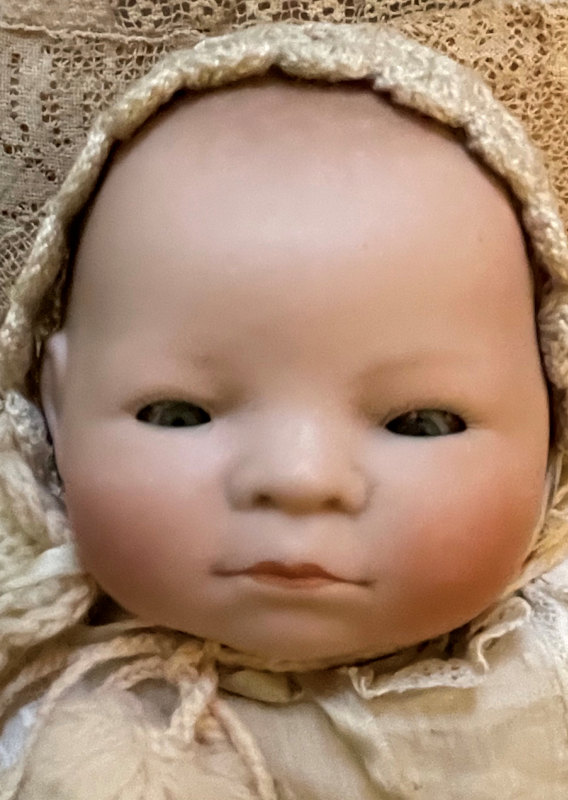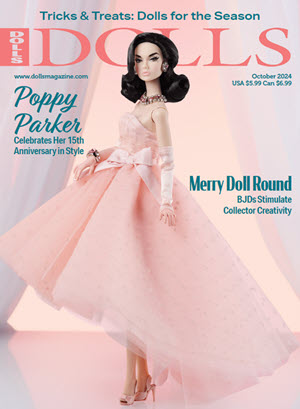By Jan Foulke
Q: I have fallen in love with Bye-Lo Babies and plan to buy one as my first antique doll purchase. Can you tell me what specifics I should look for? I don’t want to make any mistakes.
A: I, too, love Bye-Lo Babies! Their faces seem to be sweeter and have more personality than the other newborn baby models which followed them. The Bye-Lo Baby was designed by an American artist, Grace Storey Putnam, and was produced by George Borgfeldt & Co. of New York, which had the bisque heads made in Germany by such well-known porcelain factories as Kestner, Kling, Hertel & Schwab, and Alt, Beck & Gottschalck (the ABG heads were marked with mold number 1373).
The Bye-Lo Baby was the rage of the 1924 Christmas season. Customers waited in line to buy the doll, only to be disappointed when supplies ran out. People were enamored of this new style doll, a newborn baby modeled from a real 3-day-old infant. Putnam felt that such a realistic doll would bring as much joy to a little child mother as a real baby brings to their adult mother. Observing the popularity of this new style doll, other dollmakers immediately jumped into the market with their own newborn baby versions.
When buying your Bye-Lo Baby, first you should check out the bisque head. Look on the back of the head for the marking: “Copr. by Grace S. Putnam Made in Germany.” You may also see the mold number 1373 with a slash followed by the size number (the length in centimeters), but often that line is hidden by the cloth body. Examine the head carefully to make sure there are no cracks, chips, repairs, or facial rubs. Many collectors carry flashlights, as sometimes show booths are not well-lit. Check the eyes to make sure they are original and that they still sleep. If you have to find a doll hospital to repair or reset the eyes, it can add up to quite an expense.
Next look over the body. The first Bye-Los came on composition bodies, but Mrs. Putnam was not happy with the hard body and immediately designed the soft cloth body, so the composition-bodied dolls are harder to find and more expensive. I assume your first Bye-Lo purchase (you’ll find that one is never enough!) will be an example with a cloth body. Check to see that the body is correct.
It’s designed with legs curved out. Collectors call it a “frog” body. The arms are stitched on, and the hands are celluloid. Check the fingers to make sure none are broken or cracked. Celluloid becomes brittle and more fragile over the years. It’s also very difficult to repair. The bodies are stamped in purple on the front: “Bye-Lo Baby Pat. Appl’d for Copr Grace Storey Putnam.” Sometimes the mark has faded out, so for your first, make sure that the stamp is legible so you will know for sure that you have the correct original body. A voice box was fitted into the back of the torso, as a newborn baby cries, but you seldom find one that still works.
Lastly, look over the clothing. It is always nice to find an example in original factory clothes with a Bye-Lo label or a blue and white pinback button, but that may be difficult, so at least make sure that you are getting contemporary vintage clothing in good condition. You will want a diaper, undershirt, slip, dress, and perhaps a flannel half-slip and sweater. Avoid any clothing made of obviously new fabrics with heavy lace. Look for natural fibers: cotton, wool, and linen.
As I said above, one will probably not be enough. You will likely be purchasing Bye-Los in various sizes, as they came from 8 to 21 inches with the bisque heads. They also came with other types of heads: composition, celluloid, painted bisque, wood, vinyl, and wax. There were also small all-bisque models and even a very rare all-cloth baby. You will likely find this is only the beginning of your Bye-Lo collecting. Good luck and have fun!
Jan Foulke is an authority on antique and vintage dolls, with over 40 years of experience in the field. She’s the author of the full-color reference book “Jan Foulke’s Guide to Dolls” and writes the Antique Q&A column in each issue of DOLLS magazine. Send your antique doll questions to Jan Foulke.
Subscribe now to read Foulke’s column in every issue and to get access to her past columns in DOLLS online archive of past issues!









